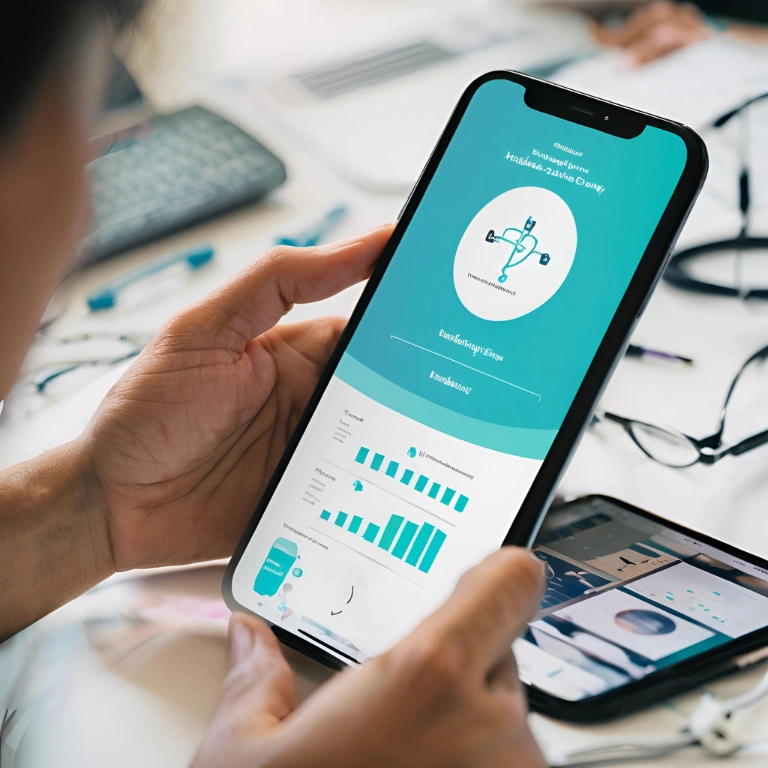
The last 4 years have made our world more online-centered. During the 2020 pandemic, everyone goes online, even healthcare providers. They start to offer various telemedical services, and users like it so much, that they decide to use healthcare apps even 4 years after the pandemic.
Now, people use telemedicine apps and leverage wearable technologies and AI tools that can show them changes in their health. The most well-known examples are female period services and smart weights apps that demonstrate not only weight, but BMI, bone, and muscle mass. Doctors often use info from this app for their diagnostics.
Without further ado, let’s dive into the specifics of healthcare app development with Corpsoft Solutions!
Specifics of Healthcare Apps
The digital health market is expected to be worth $551.09 billion by 2027, up from its present value of $220.16 billion. Most health technology funding is currently flowing into seed and early-stage startups in the medical field and wearable technologies.
The fitness industry has also witnessed a 13.7% CAGR increase in wearable technology over the past five years. AI-based tools simplify data analysis, making healthcare app development more straightforward. Projections from Markets and Markets also show a 44.9% growth in the global AI-driven healthcare space.
Some of the most well-known examples are Medisafe Pill Tracker, MySugr, TelaDoc, and Calm. They are all different, but there are a few things in common among all of them. They all have advanced data storage systems, as they must comply with the most demanding requirements and laws.
This high level of responsibility scares most startups. At this point, potential startup owners lose incredible opportunities that unlock limitless possibilities. Healthtech software is a very promising niche that can benefit each party involved.
How Can Digital Healthcare Solutions Benefit Your Business?
Medical business is one of the world’s most complex yet profitable businesses. Healthcare apps are no exception. They can improve patient engagement by providing valuable services that can improve user health. Apps can help patients take an active role in their healthcare with the following features:
- Enhanced patient outcomes with data-driven insights
- Increased access to care in underserved areas
- Streamlined administrative processes
Even though there are numerous Health apps available today, there are still many sub-niches to explore. So, you can still develop healthcare solutions that benefit your audience.
How To Start Business In Healthcare As Startup: 6 Vital Preparation Steps
It’s impossible to develop a breakthrough successful healthcare software without in-depth preparation. To ease you on this journey, we’ve gathered 6 crucial steps to pass to make your healthcare business plan come true.
Choose a Side of Healthcare
The first step in healthcare software development is to pick the side of healthcare where you want to work. It may take months or even years to switch to the other app type, even with tons of “crutches.”.
While even finance apps are more flexible and agile, healthcare tools need to comply with far more laws. It makes them harder to change. Sometimes, it can be cheaper to develop a new app from scratch than edit the current one.
So, the first thing that you need to do is to conduct marketing research and choose a suitable app type:
- Patient-focused apps: Here, patients can track their health data, manage appointments, access medical records, and receive personalized health advice.
- Provider-focused apps: They help healthcare providers manage their practices, schedule appointments, and communicate with patients.
- Administrative apps: They streamline administrative tasks for healthcare organizations, such as billing, insurance claims processing, and inventory management.
- Medical research apps: They facilitate medical research by collecting data from patients, analyzing trends, and supporting clinical trials.
Once you find the preferable sector and conduct basic marketing research that proves the necessity of your app, it’s time to move forward.
Spot Lucrative Market Opportunities
Conduct more detailed market research. Your audience is likely to be more than just patients. It can also be healthcare providers, insurance companies, etc.
Conduct a SWOT analysis of your business and main rivals. Determine customers’ pain points and decide how to fix them. Think about your potential unique selling proposition (USP). Next questions can ease this search:
- How saturated is the market?
- Do my potential competitors have a stranglehold on the industry?
- Can I offer anything different from the existing solutions?
- Can I monetize the healthcare product?
Develop strategic and tactical plans. One of the most common mistakes at this stage is to develop only a tactical plan for the next few months. You need to think from a long perspective. USE SMART (Specific, Measurable, Achievable, Relevant, and Time-Bound) technique to plan your potential goals.
Remember about your limits. Unfortunately, we don’t live in a Toy Story world where the sky is the limit. We recommend you confirm that your healthcare solutions are easy to adopt.
Check for potential limitations, whether it’s slow internet or paper-based processes or low digital literacy in rural areas. Once you have done it, we recommend you ensure that your project is compliant with all local regulations.
Ensure Compliance with Local Regulations
The health industry is one of the most regulated industries. The next step in your healthcare software development is to check that you comply with local laws.
For instance, if you create a telemedicine app for Germany, you need to verify that it adheres to both EU and German regulations. If it’s a global app, assure that your service will comply with all countries цруку you wish to present your service.
The most well-known regulations are the Health Insurance Portability and Accountability Act (HIPAA), Patient Safety and Quality Improvement Act (PSQIA), Agency for Healthcare Research and Quality (AHRQ), etc.
Develop a Monetization Model
Another common mistake during healthcare startup planning is to “forget” about monetization. Many startup teams decide, “Well, we’ll think about it later,” and it’s their greatest regret. They spend months on development to discover that no monetization strategy can help them become commercially successful. That’s why we encourage you to find a preferable monetization model as early as the planning stage. Most medical startups use 5 monetization models:
- Freemium: Some features are free, but the key functions are behind a paywall.
- Flat rate pricing: Users get complete functionality for a fixed recurring price.
- Pay-as-you-go: The price scales depending on the usage metrics per customer.
- Tiered: The solution has multiple fixed prices that depend on features and other usage conditions.
- Per-user: You charge based on the number of active users per account.
Try to balance your costs and value for your target audience. It’s better to spend a few additional weeks of healthcare web development rather than create a platform that won’t commercialize.
Pitch Your Project To Stakeholders To Raise Funds
Healthcare business require serious investments, both time and funds. While you can save up a few months by hiring an additional team, you still need money to fund your company. You can raise money for their business ventures from several sources, including private and public investors. The most common funding sources are:
- Venture capital (VC) funds. According to The Washington Post, 4% of startups get VC funding. It can be one of the sources to fund your medical business ideas, but you shouldn’t solely rely on them.
- Accelerators. These fixed-term, cohort-based programs include mentorship and educational components to raise small startups in exchange for equity.
- Angel Investors. These are individuals or companies who fund startups in exchange for convertible debt or ownership equity. Depending on the case, it can be a one-time investment or constant funding.
- Charitable Grants. Healthcare startups can obtain capital from NGOs and charities dedicated to medicine and healthcare. For instance, the Juvenile Diabetes Research Foundation (JDFR) and PureTech collaborated to fund a startup that focuses on type-1 diabetes research.
- Public funding. Government agencies like the NIH create special projects to provide capital for research and development in the healthcare field.
- Private funding. It’s one of the most common startup funding sources. Most entrepreneurs want to remain independent, so they prefer to fund themselves independently. Other personal funding sources include inheritance, contributions from friends and family, and bank loans.
You can mix multiple funding sources. But if you use external funding like VC or angel investors, you need to ensure that they allow you multiple donors. Keep in mind that each case is different.
Gather a Team
The main thing about every project is the people behind it. So, you should think about the core team and the expert team. Yes, they are two different teams, even if they work in the same division.
The core team consists of co-founders, a CTO, a COO, and a CMO with vast experience in healthcare apps. It guarantees a well-coordinated work. This “dream team” is the face of the project. They not only manage but also mentor teams, select the tech stack, and map all production.
We also recommend you hire a medical advisory board so they can consult you on medical aspects to bulletproof your business model. They will tell you which features you need in your healthcare startup and which you can skip without hesitation.
Expert teams are usually hired or outsourced professionals that get the job done. They will provide exceptional service, but they are less likely to attend different events, such as exhibitions, as the “face of the company.”
You can safely provide development and testing to outside teams. They are interested in providing an exceptional service to get a testimonial, while you can bypass the need to actually hire. You can collaborate with them as “external experts”
We recommend you cooperate with coherent teams, not individual freelancers. This decision saves you money on hiring staff while you still get experts for your project. It would be great if they had a cultural background similar to yours. It will save you days or weeks on communication since you’ll know those teams have the same taste and work ethic as you.
Once you are done with preparation, it’s time for healthcare development!
9 Stages Of Healthcare App Development
Once you’ve done all the preparation steps, it’s time to make your dreams come true. The actual development will take at least 5-8 weeks, but all efforts will pay off with the wonderful user-friendly healthcare startup app!
Planning Job Scope
Plan the timing of developing healthcare MVP (Minimum Valuable Product) and its further improvement. The best way to do it is by using an agile development approach.
You plan a project as a set of interconnected mini-projects (sprint) that can last from week to month. After each sprint, you’ll review what the team has done. You are free to modify planning and change deadlines and features. Meanwhile, traditional approaches like waterfall are more rigid and less transformable.
The medicine application market is constantly changing, so agile methodology suits healthcare web app development the best. Breaking down projects into smaller iterations lowers potential risks and fastens the bug-fixing process.
Create a Detailed App Specification
The next step, whether you create apps or websites for doctors, is to create a detailed platform description, including potential features, interface, etc. The more detailed your description, the better. If you can add mockups, wireframes, and other visualizations, do so.
Specify all specs, including hardware and software requirements. Describe all technologies and why you use them. If some technology becomes no longer compliant with the regulations, you’ll easily identify what to replace.
It is especially relevant for AI healthcare startups, as artificial intelligence and machine learning are some of the most rapidly changing technologies in the world.
Pick The Design Approach
The next step in the development process is to choose a suitable design approach. It can be custom, templated, or mixed.
If you choose the first design approach, you can create a unique interface, but you should understand that it takes a lot of time for both designers and developers to create it. However, you are free to change and scale it whenever and however you want to.
Meanwhile, the templated approach is simple but suits only simple solutions. It may suit you if you need to create a healthcare website design for basic services, like booking an appointment. Keep in mind that if you want to create something that integrates various complex features, you may need a different approach. Once you decide on the preferable healthcare UX design, it’s time to develop a minimum valuable product (MVP). It is still too early to publish your platform, but you’ve just become one step closer to it!
MVP (Minimum Valuable Product) Development
Minimum Valuable Product (MVP) is the earliest version of the product that is ready to be used by the earliest adopters. Some call it the “beta-test version”; some call it “Should we release it?.”. But they all agree that MVP is has all critical features and ready for real-world usage.
The goal of an MVP is to test the market, gather feedback, and learn from the actual clients’ usage before investing heavily in further development. It’s crucial to develop a stable healthcare MVP since it will act as a foundation for your service for years.
With MVP, you can safely test healthcare product design and gather feedback from patients, healthcare providers, and other stakeholders. By launching an MVP, you can identify potential risks and challenges before investing significant resources into a fully-fledged product.
A custom-built MVP can be precisely designed to meet your unique requirements and target audience. You also have full control over your future service’s features, functionality, and design. However, it takes more time and resources to create a functioning platform.
At the same time, templated options require fewer resources, including development time. Meanwhile, it limits potential customization and lowers potential uniqueness. Using a template may also lead to conflicts with your brand identity or specific requirements.
Ensure Regulation Compliance
We know you’ve already researched potential regulation compliance during the preparation stage. However, the medical industry is one of those places that has become increasingly regulated day by day. So, it’s better to double-check that your platform complies with all specific local regulations even after creating MVP.
Additionally check the validity of data privacy, security, and patient consent. Implement advanced security measures, such as encryption, to protect sensitive data.
Conduct a PIA (Privacy Impact Assessment) to assess the potential impact of your app on user privacy. Establish a clear data retention policy to comply with regulations and minimize data storage.
If you fail to comply with regulations, you may face severe consequences: from fines and negative publicity to lawsuits, regulatory investigations, and even criminal charges. It depends on what compliance you violated. Keep in mind that one small mistake can lead to unforeseeable consequences.
Testing
Congrats on a successful MVP! But it’s still too early to release your platform. Healthcare testing may take weeks or even months, but you still have to evaluate your service to ensure that it’s user-friendly, complies with the latest security measures, and has no major bugs.
You should conduct the next 5 tests before releasing your app:
- Functional Testing: Check whether all app features work as intended. Ensure seamless integration with other healthcare systems.
- Usability Testing: Estimate the app’s ease of use, identify potential usability issues, and make necessary improvements.
- Security Testing: Determine potential service vulnerabilities to security threats and fix them. Implement robust security measures to protect user data.
- Performance Testing: Evaluate the app’s speed, responsiveness, and stability under different loads. Optimize them.
- Interoperability Testing: Test the app’s compatibility with different devices, operating systems, and healthcare systems.
Usually, testing takes at least 2-3 weeks. Don’t try to cut corners, as it may lead to missed bugs and failure points. It’s better to meticulously check the app before uploading it to the app store.
Obtain Necessary Approvals and Certifications
Once you are done with your development, it’s time to fill out an App Store submission. You can skip this step if you are doing only the website.
Review the app store guidelines to ensure your app meets its content, functionality, and user experience requirements. Pay attention to specific guidelines for healthcare apps, such as data privacy, security, and medical claims.
Provide accurate and informative metadata, including the app’s name, description, keywords, and screenshots. Use clear and concise language that effectively communicates the app’s benefits. Create high-quality screenshots and videos that showcase the app’s features and user interface.
Wait until the app store provider (Google, Apple, etc) validates your application. Be prepared for the app store review process, which may take 2-4 weeks. Address any feedback or issues raised by the reviewers.
Start the Promotion
Finally, it’s time for healthcare marketing! Don’t rush the process, but don’t expect everything will work itself out. Slowly, yet surely, build marketing hype.
Start search engine optimization. It increases your organic traffic, enhancing brand visibility. SEO-friendly UI (user interface) practices will make your platform even more easier to understand. For businesses with a physical location, local SEO can help attract customers from your geographic area.
You need at least 2-3 months to see the first results, so the time slot after the App Store submission bet before the release is perfect to start the content marketing.
Reach out to relevant media outlets to generate press coverage for your app. Begin some strategic partnerships as part of your healthcare digital marketing: Collaborate with other healthcare organizations, companies, or influencers to reach a wider audience.
Release the App
Once your app is approved by the app store, it’s time to release it. We recommend you intensify healthcare marketing measures 2-3 weeks before the release to ensure that you’ll get the most out of it.
Beware that you still can find some unexpected bugs even after the release. Collect the user feedback and solve problems as fast as possible. Release improvements at least once a month.
Specifics of Marketing for Healthcare
Contact all potential target audiences, from patients to doctors and healthcare institutions, if it fits your case.
Determine overlooked needs, as they are also common in the healthcare niche. Many startups are so afraid of risk that they focus on a single feature, afraid to expand.
This fear leads to situations where businesses are afraid of the smallest changes, even small changes such as modifying healthcare website design. Eventually, it can lead to failure, so don’t be afraid to experiment.
In the medical field, you are legally responsible for every word you say, even in marketing. Think about promoting your product with plain words, and don’t over-advertise it with potentially slippery words.
Confirm your statements with research results. Ensure that your project provides both healthcare and commercial value. Don’t concentrate solely on a specific part of the target audience. It can be fatal for your startup.
Medical digital platforms, particularly those offering health advice or treatments, bear a significant responsibility. If you fail to validate the insight with the actual research, it may lead to misdiagnosis and mistreatment, loss of trust, and even patient harm. In this case, they will have a full right to sue the platform. You don’t want it, didn’t you?
How much would it cost to develop a healthcare app?
Usually, it takes 5-12 weeks to develop a simple average app. The final deadlines depend on the project’s complexity. While some easy platforms just need 5-7 weeks, others may require 15-20 weeks to develop a solid product.
In most cases, the whole project requires $30-40k of investments, from market research to the actual release and post-release support.
It’s necessary to understand that a whole team is behind each project. So, all these investments are used to pay salaries and use paid instruments and libraries to provide you with the best possible healthcare app.
Start Your Healthcare Startup With Corpsoft Solutions
We, Corpsoft Solutions, are a team ready to help you fulfill your dream of getting a great healthcare application. We are a well-coordinated expert team constantly looking for new challenges and exciting projects.
All our staff is based in North America and East Europe, so we know the latest North American and European regulations. You can be sure that your future project will comply even with the strictest regulations!
One of our latest projects is the RemoniHealth: custom telemedicine software on WordPress, where we’ve completed each development stage, from research and medical website design to marketing and post-release maintenance.
Are you ready to start your journey in the health sector? Contact the Corpsoft Solutions team!
Subscribe to our blog


